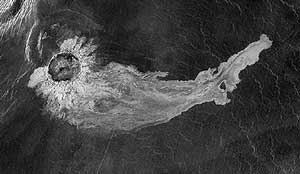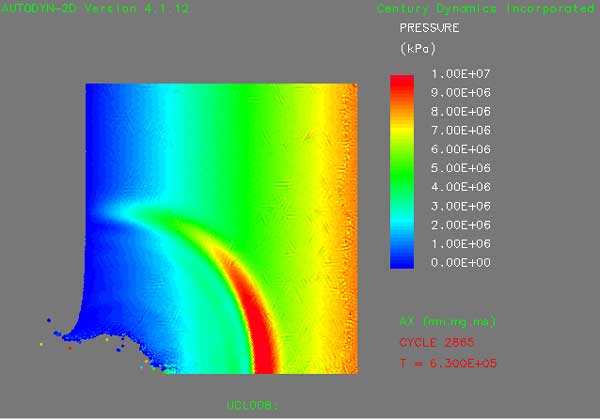 |
 |
Impact-induced
decompression melting: A possible trigger
for volcanism and mantle hotspots?
|
|
|
Background
Ever since the acceptance of the Huttonian principle of uniformitarianism,
it has been difficult for Earth scientists to accept
any explanation of a geological event that relies on
a catastrophic mechanism. This problem is epitomized by the time that was
taken to recognize the importance of meteoritic impacts
in planetary evolution. Thus, even the origin of lunar
craters was strongly debated until the middle part of
the 20th century, and until the 1950s, geologists were
reluctant to accept an impact origin for Meteor Crater
(Arizona), which is arguably one of the best preserved
of all terrestrial craters. Since then, the number of
accepted terrestrial craters has risen at a rate of
about 3 per year, and currently stands at ~150, with
no indication of a reduction in the rate of detection.
The recognition of a geological feature as having
an impact origin generally rests on observing a number
of characteristic shock-related effects in the country
rock. Some researchers, however, have gone beyond these
accepted limits to suggest that several larger geological
features had an impact origin, but have auto-obliterated
the traditional evidence of impact by subsequent large-scale
igneous activity. Examples of such suggestions
include the Bushveld Complex (Hamilton,
1970, Rhodes, 1975), the Deccan Traps (Rampino, 1987; Negi et al., 1993), the breakup of tectonic plates (Seyfert
& Sirkin, 1979;
Price, 2001), the formation of oceanic plateaus and large
igneous provinces (LIPs) (Rogers,
1982; Jones
et al.,
2002; Coffin
& Ingle, 2003,
Ingle & Coffin,
2003a,b), and the coronae of Venus (Stewart
et al., 1993; Vita
Finzi & Howarth,
2003; Hamilton, 2005, 2007). These suggestions have usually been rejected on
the grounds that an impact model is less plausible than
the widely accepted plume model (Mahoney &
Coffin, 1997; Richards et al., 1989).
 |
Melosh (1989) contended that there is no firm evidence that impacts can induce volcanic
activity in the impact crater region,
although studies of the Addams Crater on Venus
and the Sudbury complex in Canada seem to be at
odds with this claim.
Figure 1: Addams crater is
remarkable for the extensive outflow that extends
600 km from the crater rim. |
|
Revisiting
the hypothesis
Hydrodynamic modelling could investigate whether the degree of
melting generated by a large impact into hot lithosphere
produces more melting than predicted from classic scaling
laws (Jones
et al., 2002). Central to our analysis is the contention that the phenomenon of pressure-release
melting, or decompression melting, is the key to understanding
the volumes of melt generated during large impacts and
that in part this process has been overlooked or wrongly
de-emphasized. We conclude that decompression melting
of the sub-crater mantle may initiate almost instantaneously,
but the effects of such a massive melting event may
trigger long-lived mantle upwelling.
The energy released is largely derived from gravitational
energy. This is outside (but additive to) the conventional
calculations of impact modelling, where energy is derived
solely from the kinetic energy of the impacting projectile,
be it comet or asteroid. Therefore the empirical correlation
between total melt volume and crater size no longer
applies, but instead is non-linear above some threshold
size, depending strongly on the thermal structure of
the lithosphere.
We used
indicative hydrocode simulations to identify regions
of decompression beneath a dynamic, large impact crater. The volume of melting due to decompression was then
estimated, from comparison with experimental phase relations
for the upper mantle, and depends on the geotherm.

Figure
2: Indicative hydrocode model of a simulated impact
designed to show regions where decompression melting
should occur. Model conditions: 300 x 300 km cell,
impactor = 10 km radius iron, velocity 10 kms-1,
orthogonal impact, target = basalt (homogeneous), pressure
gradient = PREM ; See Jones
et al. (2002).
We suggest
that the volume of melt produced by a 20-km-diameter
iron projectile travelling at 10 km/s into hot oceanic
lithosphere may be comparable to a LIP (i.e. of the
order of ~106 km3). The mantle
melts will have "plume-like" geochemical signatures, and
rapid mixing of melts from sub-horizontal sub-crater
reservoirs to depths where garnet and/or diamond is
stable is possible. Direct coupling between impacts
and volcanism is therefore a possibility that should
be considered in the context of global stratigraphic
events in the geological record.
Maximum melting would
be produced in young oceanic lithosphere and could produce
oceanic plateaus, such as the Ontong Java plateau at
~120 Ma. The end-Permian Siberian Traps could also have resulted from volcanism triggered by a major impact
at ~250 Ma, onto continental or oceanic crust. Auto-obliteration
by volcanism of all craters larger than ~200 km would
explain their anomalous absence on Earth compared with
other terrestrial planets in the solar system. This
model provides a potential explanation for the formation
of komatiites and other high-degree partial melts. Impact
reprocessing of parts of the upper mantle via impact
plumes is consistent with models of planetary accretion
after the late heavy bombardment and provides an alternative
explanation for most primitive geochemical signatures
currently attributed to plumes as originating from the
deep mantle or the outer core. |
Discussion
Recently Ivanov & Melosh (2003) concede:
"Consider an impact
that creates a transient cavity approximately twice
as deep as in our numerical simulation (depth ~100 km).
Such an impact is, indeed, big enough to raise hot mantle
rocks close to surface. This impact corresponds to a
final crater diameter of 400 to 500 km a very rare
event in the current post-heavy bombardment period.
Such a huge event IS possible.." (and would
trigger volcanism).
The question that needs still to be refined is
how large an impactor is needed to generate large scale
melting, and what is the effect on the thermal structure
of the lithosphere on the volume of melt generated.
It is to be expected that considerably more melt will
be generated when an impact penetrates thin oceanic
lithosphere (e.g., under the Ontong Java plateau) than
if the same impact landed on thick continental crust. We also note that Glikson (1999) pointed to the planetary-scale role of mega-impacts
in the history of development of the Earth’s crust,
and drew attention to the likely preferential melting
efficiency of mega-impacts in oceanic lithosphere due
to their higher geothermal gradients and thinner crust.
Many of Glikson’s ideas and fundamental implications
are substantiated by our results for decompression melting.
We finish
by quoting Boslough et al.
(1986), who stated "the impact-produced
flood basalt hypothesis is attractive because it is
potentially testable on the basis of predictions of
features that have not yet been discovered...unlike
current plume models for flood basalts and hotspots".
In conclusion, we assert that the concept of impact-induced
volcanism has not been adequately examined and may offer
a new framework for the interpretation of large-scale
igneous and geological processes. |
References & Bibliography
-
-
Boslough M.B, Chael E.P., Trucano T.G, Crawford D.A. and
Campbell, D.I. (1986) Axial focusing of impact energy
in the Earth’s interior: a possible link to flood
basalts and hotspots, in: G. Ryder, D. Fastovsky,
S. Gartner (Eds.), The Cretaceous-Tertiary Event
and Other Catastrophes in Earth History, Geol.
Soc. Am. Spec. Publ. 307 541.
-
Coffin
M. F. and Ingle S. P. (2003) Impact origin of the
Greater Ontong Java Plateau?, IUGG (abstract),
Japan, JSV03
-
Glikson, A.Y. (1999) Oceanic mega-impacts and crustal evolution, Geology,
27, 387-390.
-
Hamilton, W.B. (1970) Bushveld complex product of impacts? In; J.L. Vissler,
G. Von Gruenewaldt (Eds.), Symposium on the Bushveld
Igneous Complex and Other Layered Intrusions,
Geol. Soc. S. Afr., Spec. Publ. 1, 367-379.
-
Hamilton, W.B. (2005), Plumeless Venus preserves an ancient impact-accretionary surface, in Plates, Plumes, and Paradigms, edited by G.R. Foulger, J.H. Natland, D.C. Presnall and D.L. Anderson, Geological Society of America Special Paper 388 781-814, Boulder, Colorado.
-
Hamilton, W.B. (2007), An alternative Venus, in Plates, Plumes, and Planetary Processes, edited by G.R. Foulger and D.M. Jurdy, Geological Society of America Special Paper 430, 879-912, Boulder, Colorado.
-
Ingle
S. and Coffin M. (2003a) Impact origin of the Ontong
Java Plateau? Geochemical and Petrological evidence.
Geophys Res Abstr, 5, EGS-AGU-EUG Joint Assembly
Nice, Abstract
EAE03-A-05038
-
Ingle
S and Coffin M. (2003b) Impact origin of the Ontong
Java Plateau? Geophysical and Geodynamic evidence.
Geophys Res Abstr, 5, EGS-AGU-EUG Joint Assembly
Nice, Abstract
EAE03-A-03328
-
Ivanov
B. A. and Melosh H. J. (2003) Impacts do not initiate
volcanic eruptions. Lunar and Planetary Science
XXXIV abstracts
PDF 1338.
-
-
Jones
A.P., Price G.D., De Carli, P.S., Price, N.J., Clegg,
R.A. (2003) Impact decompression melting: a possible
trigger for impact induced volcanism and mantle
hotspots? In: Impact markers in the Stratigraphic
Record (eds. C. Koeberl and F. Martinez-Ruiz),
Springer, Berlin, p 91-120.
-
Mahoney, J.J. and Coffin M.F. (Eds.) (1997). Large Igneous Provinces,
Am. Geophysical Union, Geophys. Monogr. 100, 438
pp.
-
Melosh, H.J. (1989). Impact Cratering, A Geological Process,
Oxford Monograph Geol. Geophys. 11, 245 pp.
-
Negi, J.G., Agrawal P.K., Pandey O.P, and Singh, A.P. (1993).
A possible K-T boundary bolide impact site offshore
Bombay and triggering of rapid Deccan volcanism,
Phys. Earth Planet. Int., 76, 189-197.
-
Price, N.J. (2001). Major Impacts and Plate Tectonics, Routledge,
London 416 pp.
-
Rampino, M.R. (1987). Impact cratering and flood-basalt volcanism,
Nature, 327 468-468.
-
Rhodes,
1975, New evidence for impact origin of the Bushveld
Complex, South Africa, Geology,
3, 549-554.
-
Rogers G.C. (1982). Oceanic plateaus as meteorite impact signatures,
Nature, 299, 341-342.
-
Seyfert, C.K and Sirkin L.A. (1979). Earth History and Plate Tectonics,
Harper and Row, New York, 96 pp.
-
Stewart,
C.A., Rampino M.R. and Robinson C.A. (1993). Impact
shocks in the transition zone: Enough energy to
trigger a plume? Venus coronae linked to missing
population of large Venus impact craters? EOS
Supplement, Oct. 26, 80.
-
Vita
Finzi C., and Howarth R. J. (2003). Impact origin
of Venusian coronae, manuscript in preparation.
|
|
|
